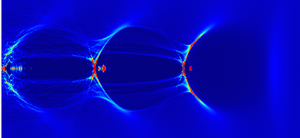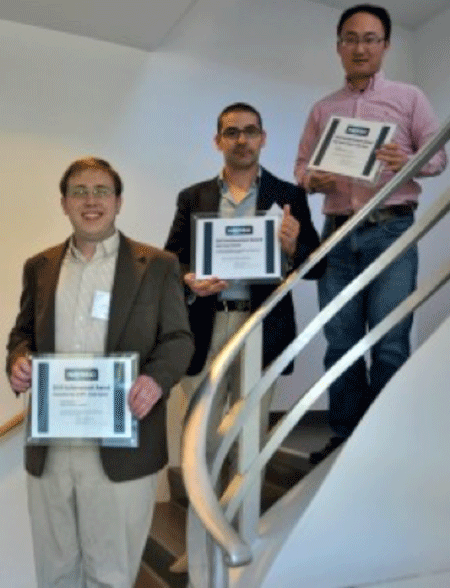BLAST codes and algorithms, and their uses in making better accelerators, have been the subject of a number of news stories as well as papers in the scholarly literature. Here are some good places to start.
New BLAST Library: Optimas
We released a new Python for scalable optimization on massively-parallel supercomputers library: Optimas!
Optimas is developed by LBNL and DESY, in collaboration with ANL scientists for libEnsemble. Read more in its documentation.
New BLAST Code: Wake-T
Wake-T (Wakefield particle Tracker) joins the BLAST codes! Wake-T is developed at DESY and continues to be closely integrated with the BLAST open standards, in particular for the design studies of laser- and beam-driven wakefield accelerators.
Wake-T is a particle tracking code that makes use of reduced physical models to allow for fast simulations. Read more on Wake-T in its documentation.
2022 ACM Gordon Bell Prize
Members of the WarpX team, partnering with international collaborators in France and Japan, won the 2022 ACM Gordon Bell Prize! The Gordon Bell Prize is the highest computational science award in the field of supercomputing, presented by the Association for Computing Machinery each year in conjunction with the SC Conference series.
Read more on WarpX breakthrough to Exascale in these recent news releases:
- ATAP: Berkeley Lab-Led WarpX Project Key to 2022 Gordon Bell Prize
- NERSC: WarpX Code Shines at the Exascale Level
- ECP supported collaborative teams win the 2022 ACM Gordon Bell Prize and Special Prize including a podcast episode of the lead authors of the award-winning publication
— Berkeley Lab’s researchers, unique capabilities aided international effort to probe fundamental questions in physics
Cracking Open Strong-Field Quantum Electrodynamics
“A powerful demonstration of how advanced simulation of complex systems can enable new paths for discovery.”
— ATAP Division Director Cameron Geddes
A newly published theoretical and computer modeling study, which relied upon the WarpX code, suggests that the world’s most powerful lasers might finally crack the elusive physics behind some of the most extreme phenomena in the universe — gamma ray bursts, pulsar magnetospheres, and more. The international team behind the study includes researchers from Lawrence Berkeley National Laboratory (Berkeley Lab) and France’s Alternative Energies and Atomic Energy Commission (CEA-LIDYL). They report their findings in a 10 September 2021 Physical Review Letter. Learn more…
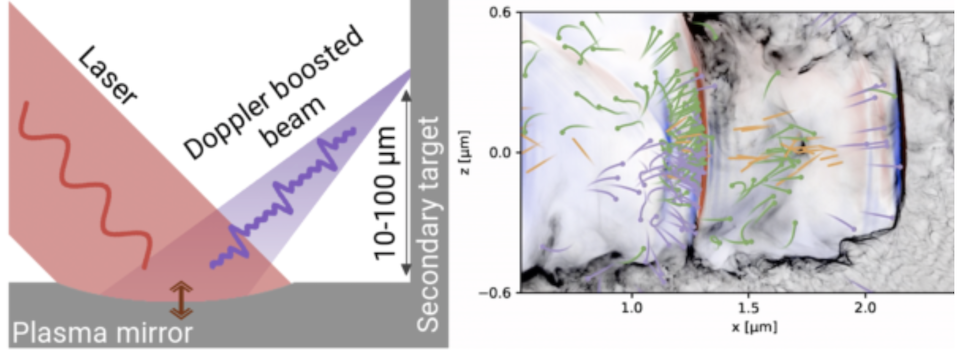
Left: In the proposed scheme for probing SF-QED with present-day or near-future lasers, a plasma mirror shaped by radiation pressure converts an intense laser pulse (red) into Doppler-boosted harmonics (purple) and focuses them on a secondary target, reaching extreme intensities. The dimensions involved are tens to hundreds of microns (millionths of a meter); the diameter of a human hair is a few to several tens of microns. (Credit: Luca Fedeli/CEA)
Right: Berkeley Lab’s key contribution was leading the development of the simulation code used for the research. In this simulation image, the intense Doppler-boosted light pulses (red and blue) plow through the solid target (gray), generating high-energy photons (orange) that decay into pairs of electrons (green) and positrons (purple) after further interaction with the incoming light pulses. The electrons and positrons are separated due to the strong laser field. Only photons that have not yet decayed into pairs are shown. (Credit: Luca Fedeli/CEA)
Perlmutter Cluster Launches with WarpX
On May 27th, 2021, NERSC launched DOE’s newest supercomputer: Perlmutter. WarpX was one of the very first codes to run on Perlmutter’s GPUs!
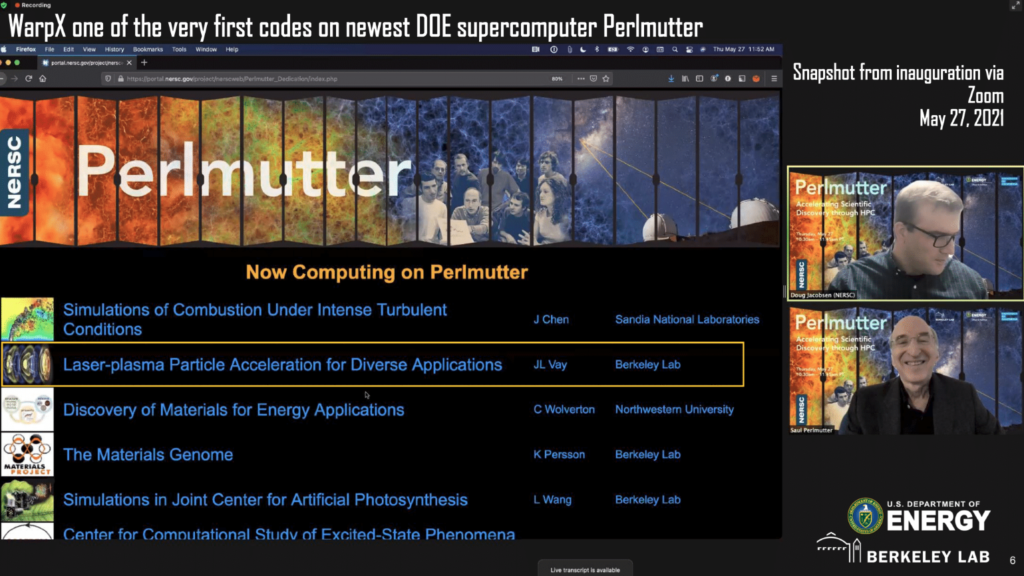
A New Meaning for BLAST
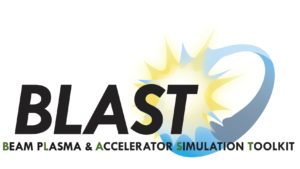 In order to give credit and a shout-out to the growing number of international contributions to open-source BLAST codes, we decided to rename the BLAST acronym in 2021. From now on, BLAST stands for the Beam, Plasma & Accelerator Simulation Toolkit.
In order to give credit and a shout-out to the growing number of international contributions to open-source BLAST codes, we decided to rename the BLAST acronym in 2021. From now on, BLAST stands for the Beam, Plasma & Accelerator Simulation Toolkit.
We are excited to continue to grow the community around the simulation toolkit with our collaborators from LIDYL (CEA, France), SLAC (USA), LLNL (USA), DESY (Germany), UHH (Germany), HZDR (Germany), Radiasoft (USA), CERN (Switzerland) and more!
LASER PLASMA MICROSOURCE ENABLES BI-MODAL IMAGING
An international team, including ATAP scientists Tobias Ostermayr of the Berkeley Lab Laser Accelerator Center and Axel Huebl of the Accelerator Modeling Program, has made the first proof-of-principle demonstration of bi-modal radiographic imaging for biological and technological objects with a laser-driven microsource of x rays and protons. The results were announced December 2 in the journal Nature Communications.
[more]
Ostermayr is lead author of the paper and (together with co-corresponding author Joerg Schreiber of Ludwig-Maximilians-Universität München and Max-Planck-Institut für Quantenoptik) originated the idea. Huebl performed particle-in-cell simulations in support of the study. The experiments were performed with the Texas Petawatt Laser at the University of Texas at Austin.
Synchronized single-sourcing of multiple modalities
Conventional radiography machines produce only a single kind of radiation, such as protons, electrons, or x-rays. Using more than one kind of radiation source gives complementary sets of information about the specimen, but in order to take advantage of this, significant post-processing is usually needed because the sources and image acquisitions were separate in space and/or time.
Laser-driven plasmas can simultaneously emit multiple forms of radiation, including x-rays and protons, and they produce it in short bursts, which is also desirable for, say, “freezing” motion. This study demonstrated, for the first time ever, how such a laser-driven source can be used to make images of biological and technological samples.

In this conceptual illustration, a test object (a cricket) casts shadows in a proton beam (green) and an x-ray beam (blue) to record radiographic images with both beams in a single laser shot. The proton image is color coded in blue and red, immediately downstream of the test object; the x-ray image is the grayscale plane at far right. The images show actual experimental data. The laser plasma provides a single source of protons and x-rays, intrinsically synchronized on the nanosecond scale and originating (within µm) from the same spot, as compared to existing, separate sources of these two imaging modalities. Illustration by Tobias Ostermayr, Berkeley Lab.
The team achieved intrinsic nanosecond-scale synchronization of these two powerful and important imaging techniques (compared to seconds or minutes in conventional machines), and the two radiation sources overlapped on a scale of a few micrometers. These attributes, combined with the exquisitely small source size enabled by laser plasma techniques, gave sharper and more detailed insights into materials and samples than could be expected from either source alone—a unique capability of laser plasmas.
In the near future, the researchers hope to extend multimodal imaging capabilities and applications to include electrons and neutrons, and to image dynamic events.
To learn more…
T.M. Ostermayr et al., “Laser-driven x-ray and proton micro-source and application to simultaneous single-shot bi-modal radiographic imaging,” Nature Communications 11, 6174 (02 December 2020).
“A new laser-driven X-ray and proton micro-source,” Attoworld, 3 December 2020.
[/more]
LBNL – CEA Saclay Breakthrough in Modeling of Laser Plasma Interactions

Large-scale simulations demonstrate that chaos is responsible for stochastic heating of dense plasma by intense laser energy. This image shows a snapshot of electron distribution phase space (position/momentum) from the dense plasma taken from PIC simulations, illustrating the so-called “stretching and folding” mechanism responsible for the emergence of chaos in physical systems. Image: G. Blaclard, CEA Saclay
A new 3D particle-in-cell (PIC) simulation tool developed by researchers from Lawrence Berkeley National Laboratory and CEA Saclay is enabling cutting-edge simulations of laser/plasma coupling mechanisms that were previously out of reach of standard PIC codes used in plasma research. More detailed understanding of these mechanisms is critical to the development of ultra-compact particle accelerators and light sources that could solve long-standing challenges in medicine, industry, and fundamental science more efficiently and cost-effectively.
In laser-plasma experiments such as those at the Berkeley Lab Laser Accelerator (BELLA) Center and at CEA Saclay — an international research facility in France that is part of the French Atomic Energy Commission — very large electric fields within plasmas accelerate particle beams to high energies over much shorter distances when compared to existing accelerator technologies. Supercomputer simulations have become increasingly critical to this research, and Berkeley Lab’s National Energy Research Scientific Computing Center (NERSC) has become an important resource in this effort. [more]
The long-term goal of these laser-plasma accelerators (LPAs) is to one day build colliders for high-energy research, but many spinoffs are being developed already. For instance, LPAs can quickly deposit large amounts of energy into solid materials, creating dense plasmas and subjecting this matter to extreme temperatures and pressure. They also hold the potential for driving free-electron lasers that generate light pulses lasting just attoseconds. Such extremely short pulses could enable researchers to observe the interactions of molecules, atoms, and even subatomic particles on extremely short timescales.
Click here to explore further…
Exascale Accelerator Modeling Among Highlights Featured in APS-DPB Annual Newsletter
 Each year the newsletter of the American Physical Society’s Division of Physics of Beams (APS-DPB) publishes articles about some of the most important and timely topics in accelerators and beams, written by leaders in the field. This year’s issue was edited by Alysson Gold and Nihan Sipahi, Early Career Members-at-Large of the APS-DPB Executive Committee. It features three articles directly related to ATAP’s work, including one on modeling and simulation.
Each year the newsletter of the American Physical Society’s Division of Physics of Beams (APS-DPB) publishes articles about some of the most important and timely topics in accelerators and beams, written by leaders in the field. This year’s issue was edited by Alysson Gold and Nihan Sipahi, Early Career Members-at-Large of the APS-DPB Executive Committee. It features three articles directly related to ATAP’s work, including one on modeling and simulation.
“Modeling Future Accelerators on the Eve of Exascale Computing” (pp. 16-17), by Jean-Luc Vay, head of ATAP’s Accelerator Modeling Program, describes the prospects for powerful, high-fidelity tools for the design, optimization, and perhaps even predictive control of particle accelerators. A rendering from a plasma accelerator simulation, using the BLAST code WARP3D, was chosen as the cover illustration for the report.
These are just a few of the 15 articles about exciting technical topics in our field. Click here for the Newsletter.
Profiling Extreme Beams: Diagnostic Tool Devised for Cutting-Edge and Next-Gen Particle Accelerators
To optimize the performance of particle accelerators with high-brightness beams and ultrashort pulses — and to prepare for next-generation facilities that will push these extremes further — scientists have devised a new tool that can measure how bright these beams are, even for pulses that last only femtoseconds or attoseconds. This tool, dubbed a “charge density monitor,” can also measure beam sizes to within a few tens of nanometers (billionths of a meter) without disrupting experiments that rely on these beams. BLAST codes and the Accelerator Technology and Applied Physics Division are playing key roles in this effort. To learn more and see videos of the simulations, visit the Berkeley Lab News Center.
Taking Accelerator Simulations to the Exascale
The Department of Energy’s Exascale Computing Project (ECP) has announced support for 15 critical research applications for next-generation supercomputers, and LBNL’s Accelerator Technology and Applied Physics Division will lead one of them: “Exascale Modeling of Advanced Particle Accelerators,” headed by Dr. Jean-Luc Vay.
See also “The Incredible Shrinking Particle Accelerator,” an article by Kathy Kincade of the National Energy Research Supercomputing Center, which puts accelerator simulation in the context of other computational research, supercomputing, and visualization capabilities at LBNL.
Inaugural BLAST Workshop Brings Developers, Users Together
The Berkeley Lab Accelerator Simulation Toolkit (BLAST) — a suite of “codes,” or computer programs, that have found a wide variety of uses — were the subject of a workshop May 7-9, 2018 at LBNL.

Some of the BLAST Workshop participants in front of the venue: Shyh Wang Hall, home of Berkeley Lab’s National Energy Research Supercomputing Center (NERSC).
The workshop, organized by ATAP’s Accelerator Modeling Program, attracted 67 participants representing 25 institutions, 10 countries, 7 universities, 4 U.S. national laboratories, and 3 private-sector companies, a reflection of the diverse uses (in accelerator and plasma physics and otherwise) of the BLAST codes. The participants included both users and developers, and the three-day program combined lectures and hands-on work.
Boosted Frames Basics
A hundred-plus years after Einstein’s annus mirabilis, relativity still has a few tricks left for us to discover, and BLAST leader Jean-Luc Vay found one of them: how to make time-based simulation of relativistic physics much quicker and easier in critical areas through astute choice of an inertial frame of reference from which to look at the problem. See popular articles by the American Physical Society or the seminal technical paper on the subject, Physical Review Letters 98, 130405 (2007).
Boosted Frames and BELLA
A multidisciplinary team from BLAST, the LOASIS/BELLA program, Lawrence Livermore National Laboratory, and Tech-X Corporation uses the boosted-frame method to greatly speed up three-dimensionally simulation of a laser-plasma wakefield accelerator. A popular article and the technical paper Physics of Plasmas 18, 030701 (2011) are available online.
Does Antimatter Fall Antidown?
This seemingly simple question still puzzles physicists, in part because it is so devilishly hard to study well. With improved techniques to form, trap, and cool antimatter atoms, a number of experiments have begun studying this and a number of related questions in the field of “CPT invariance,” using atoms that are like hydrogen but made of antimatter. The Warp code played a key role in modeling the apparatus for one of these experiments.
Accelerators, Codes, and Clean, Cheap Energy
One approach to controlled fusion energy is through inertial confinement, in which a small capsule of fusion fuel is heated and compressed, so that the fusion reaction take place before the fuel flies apart. LBNL has the long-range goal of developing powerful, energetic heavy-ion accelerators that will not only “drive” a fusion target, but also have cost, efficiency, and reliability that make business sense as the basis for a power plant. The emergent and related science of high-energy-density physics with laboratory plasmas— “the X Games of contemporary science” by a National Research Council committee— a natural match for the same experimental facilities, modeling techniques, and other areas of expertise. The Laboratory’s flagship facility in this area is the Neutralized Drift Compression Experiment II, an accelerator that has benefitted greatly from modeling; it is the home of IMPACT, one of the codes brought together in BLAST.
Recognition for BLAST Personnel
BELLA Simulation Team Receives NERSC HPC Award
Computer simulation of the plasma wakefield as it evolves over the length of the 9 cm long channel in BELLA. For more details on the simulation aspects, see this news release from NERSC.
For the second consecutive year, ATAP modeling work has been honored with a NERSC High Performance Computing Achievement Award. The NERSC HPC Achievement awards are given by the Department of Energy’s LBNL-hosted National Energy Research Scientific Computing Center.
The open-category award for High Impact Scientific Achievement went to the Berkeley Lab Laser Accelerator (BELLA) Center for its use of NERSC supercomputers for the modeling of laser plasma accelerators, and in particular for the importance of modeling in the successful acceleration of electrons to 4.25 GeV in only 9 cm.
Extensive simulations using INF&RNO, a code developed under Benedetti’s leadership for modeling laser-plasma interactions, showed that the experiment and causes of fluctuations in beam energy and charge are well understood. These fully self-consistent, multi-dimensional particle-in-cell (PIC) simulations ran on the Cray XC30 supercomputer “Edison” at NERSC. They were of fundamental importance in modeling the propagation of a high-intensity laser in the plasma, characterizing the nonlinear wakefield excitation, and studying the details of particle self-trapping. The results were important in planning the experiment and also in helping us understand the results.
US Particle Accelerator School Prize
BLAST team leader Jean-Luc Vay was honored in 2013 with the US Particle Accelerator School Prize for Achievement in Accelerator Physics and Technology. The USPAS Prize, given every other year, recognizes the achievements of two people in the accelerator field, one of them under 45 years of age. Vay shared the award with former AFRD senior scientist Kwang-Je Kim, who is now with Argonne National Laboratory.
The award was formally presented in October at NA-PAC’13, the North American Particle Accelerator Conference. Here are links to learn more about one of Vay’s prominent achievements, the Lorentz boosted frame technique, or about the USPAS Prize.
NERSC HPC Achievement Award
Vay was also one of the three 2014 recipients of the NERSC HPC Achievement Award. The award recognizes National Energy Research Supercomputing Center users who have demonstrated an innovative use of high-performance computing resources to solve a scientific problem, or whose work has had an exceptional impact on scientific understanding or society. Vay’s award recognized novel methods developed for and realized in the BLAST code Warp.


